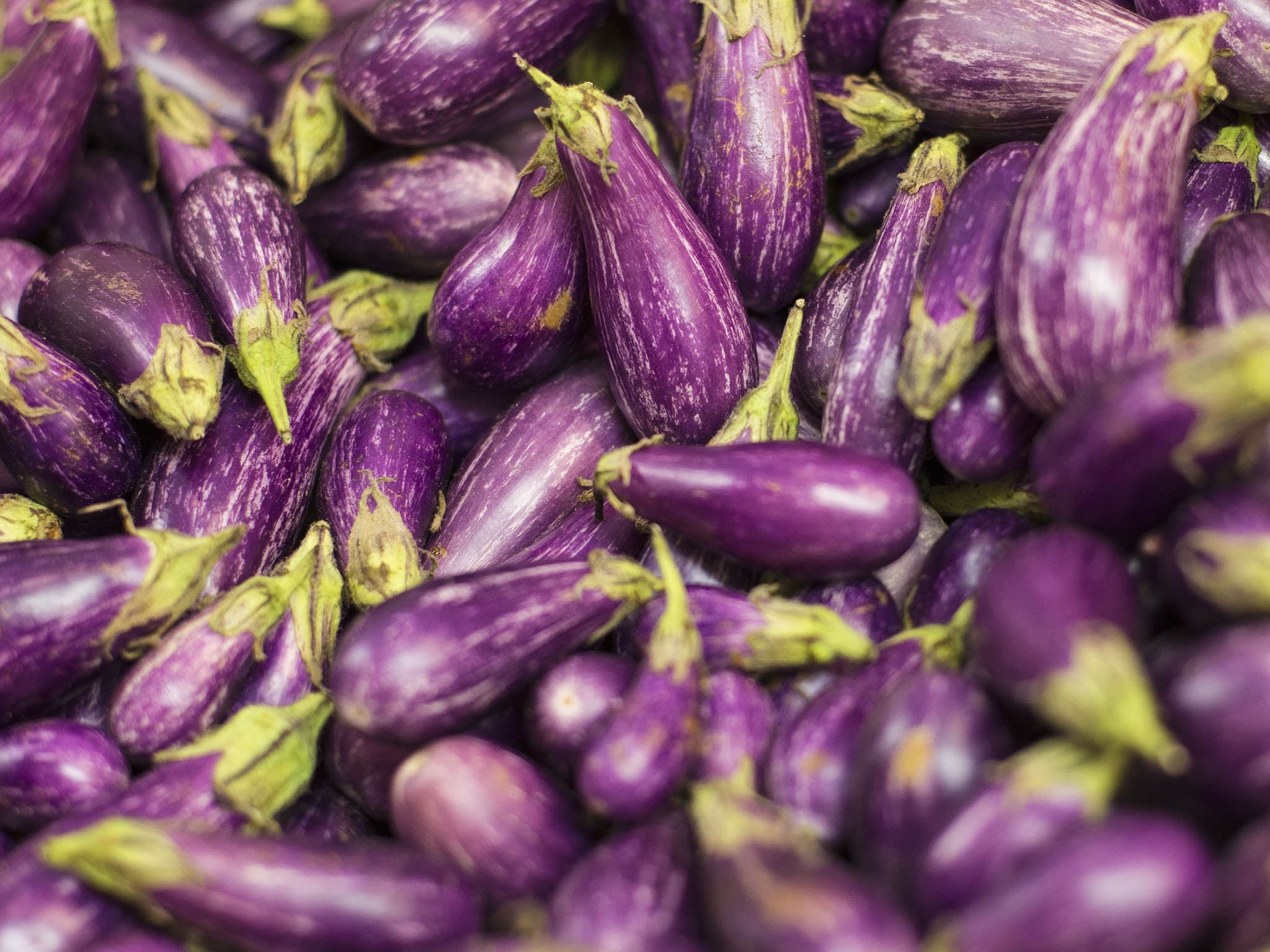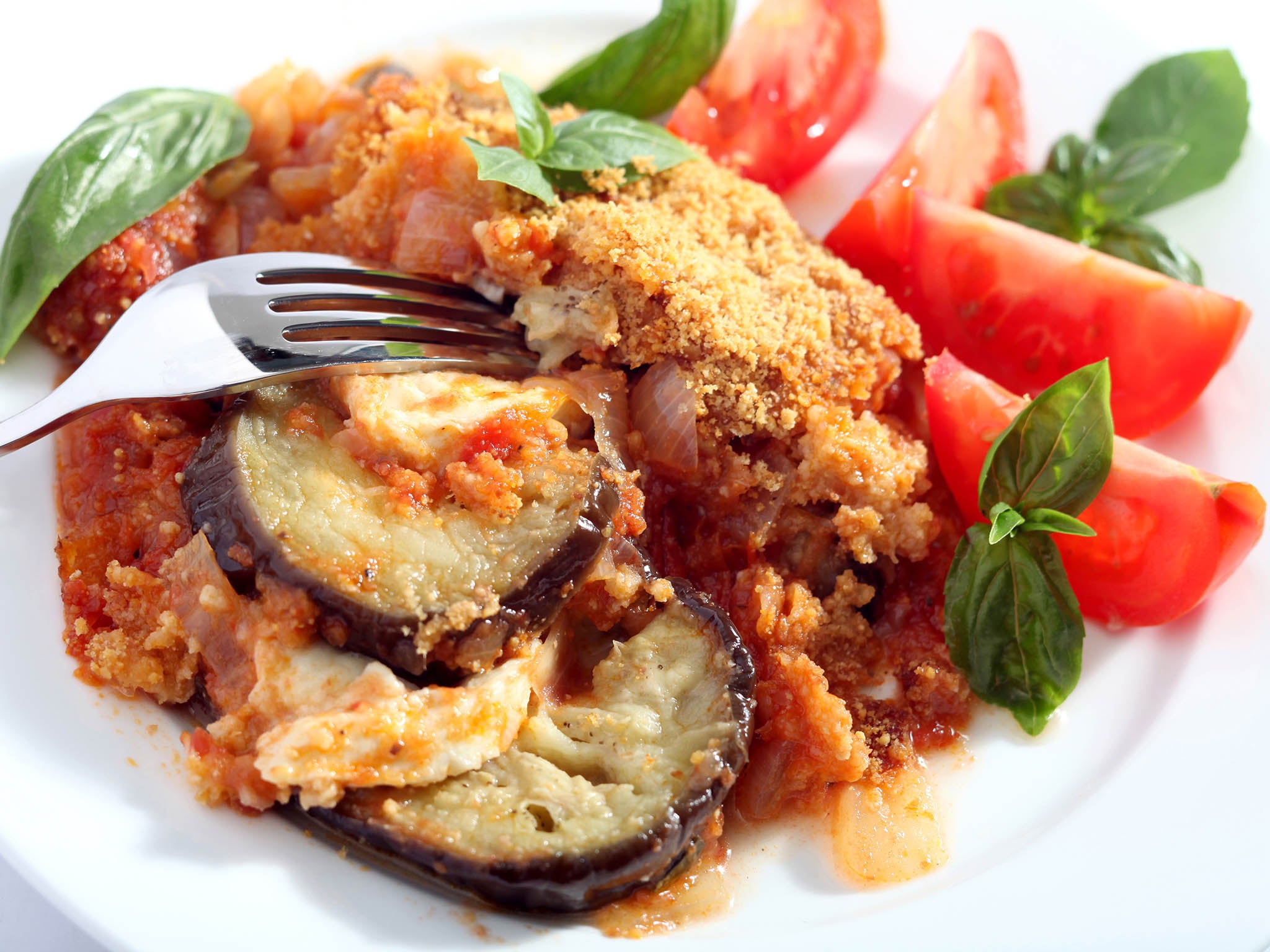How to make the perfect aubergine parmigiana
What's the best way to combine crunchy aubergine, juicy tomato sauce and melted cheese together on one plate? Julia Moskin has the answers, and Eric Asimov pours the drinks

Your support helps us to tell the story
From reproductive rights to climate change to Big Tech, The Independent is on the ground when the story is developing. Whether it's investigating the financials of Elon Musk's pro-Trump PAC or producing our latest documentary, 'The A Word', which shines a light on the American women fighting for reproductive rights, we know how important it is to parse out the facts from the messaging.
At such a critical moment in US history, we need reporters on the ground. Your donation allows us to keep sending journalists to speak to both sides of the story.
The Independent is trusted by Americans across the entire political spectrum. And unlike many other quality news outlets, we choose not to lock Americans out of our reporting and analysis with paywalls. We believe quality journalism should be available to everyone, paid for by those who can afford it.
Your support makes all the difference.“No dish has ever been devised that tastes more satisfyingly of summer,” Marcella Hazan wrote of aubergine parmigiana (known in the US as eggplant parmesan) in her definitive (and assertive) cookbook, Essentials of Classic Italian Cooking. (I might argue that if she’d never been to a clambake or a crab boil, just this once she might have been wrong.)
But at the end of the season – when the tomatoes are destined for sauce instead of salad, the aubergines are shiny and firm, and the idea of a casserole begins to seem appealing again – aubergine parmigiana beckons to many cooks. In Italy, the dish is soft and silky, with the aubergine acting as a succulent sponge for the flavours of olive oil and tomato.
But I’ve never made an aubergine parmigiana that I didn’t regret.
Draining, dredging and frying aubergine slices is a completely worthwhile kitchen project (if one of the messier ones). But according to most recipes for aubergine parmigiana, I am supposed to bury those crisp slices in a dish with tomato sauce, bake them into mush and still expect deliciousness. This never happens. The breading in the crust always soaks up the liquid, and the whole thing becomes mired in sludge.
At some point between Rome and New York, the recipe seems to have been lost in translation. In general, Italian recipes call for frying the aubergine in a light dusting of flour, making it brown and tender. American recipes often add an egg wash and breadcrumbs to make a thicker, crunchy crust. This is a great development when you are eating plain fried aubergine, but not when that aubergine is destined to end up in a casserole.
Still, I believe that aubergine parmigiana is – or should be – the perfect crowd-pleasing vegetarian entree, with its familiar flavours and satisfying richness. A main dish of aubergine has heft, unlike an entree based on broccoli or cabbage.
I was determined to reformulate the dish so that the aubergine would behave like a cutlet of veal or chicken, standing on its own crusty merits.
There are many good recipes, including Hazan’s, for aubergine parmigiana – but none for a crunchy alternative. You can make grilled and roasted, stacked and rolled, muffin-tin and mug-baked versions. But these run the risk of becoming tough or slimy or both.
In the real world, how to put crunchy aubergine, juicy tomato sauce and melted cheese together on one plate? As is often the case, the answer to my cooking puzzle was already lurking in the memory of Jacques Pépin, the French-American chef who has been cooking professionally since he was 13. (At that time in France, it was possible to leave school and become an apprentice in your teens.)
As a boy, he helped his mother in the family’s restaurant kitchen near Lyon, where he watched her make beignets d’aubergines. She’d split the large aubergine of late summer in half, then thinly slice each half while keeping the slices attached at the stem end, and dip them in a light, eggy batter.
“It was a little like tempura, and I don’t know how she knew to do it, but it worked,” he said. (She also addressed courgettes this way.)
The slices fan out prettily, and even a fat aubergine becomes flat enough to cook as a cutlet. This way of preparing the vegetable for frying is also traditional in Sicily, where the puffed, golden-brown whole aubergines are called melanzane a quaglia, or aubergine quail-style. The slices curl up and arch as they hit the hot oil, making them look like birds’ wings.
Doing this with smaller whole aubergines works beautifully. I salt the aubergines lavishly, not because of any bitterness that needs to be removed but to firm and season the flesh. (Aubergine flesh itself is almost devoid of flavour and consists mainly of fibre.)
Pressing the aubergines down as they absorb the salt helps both expel the liquid and force them into a flatter shape, the better for pan-frying.
Make sure the batter permeates all the edges and crevices of the aubergine, and then plaster the surface with panko or breadcrumbs.
Once the aubergine was addressed, I needed hot tomato sauce and melted mozzarella to complete the dish. Borrowing an idea from shakshuka, I dropped spoonfuls of mozzarella into simmering tomato sauce, left them to melt, then spooned them out together. Firm, dry-packed mozzarella melted more neatly and reliably than the soft, fresh, water-packed kind.
To keep the aubergine crisp to the very end, I placed the sauce and cheese next to the aubergine on each serving plate, but you might spoon them on top. (You also might put a bed of pasta on the plate for a truly filling meal.)
This revised classic is an excellent reminder that new ways with old dishes are always out there – and sometimes they come from our oldest sources.
And to Drink
While this recipe may revolutionise the method for preparing aubergine parmigiana, it does not change the sort of wine you want, a lively red with good acidity. White wines are best for dishes made with fresh tomatoes, but reds work better with tomato sauces like the marinara used here. Acidity is the key. You don’t want reds that are too oaky, tannic or alcoholic. That leaves plenty of choices, especially among Italian reds. Barberas from Alba or Asti in northwest Italy practically epitomize the low-tannin, high-acidity definition. Happily, lower-priced versions that were not aged in new oak will be ideal. The same is true of Chianti, made of the sangiovese grape, but steer clear of more expensive, and oaky, riservas. Valpolicella is another possibility, and if you would like some bubbles, how about a good Lambrusco?

Crunchy aubergine parmigiana
Serves 4 to 5
Time:1 hour 30 minutes
8 to 10 small aubergines
Salt
680g all-purpose flour
3 large egg yolks
680g dry breadcrumbs or panko, seasoned with 1 teaspoon each salt, black pepper, garlic powder and dried oregano
Vegetable oil, for frying
1kg tomato sauce, preferably homemade
4 to 6 ounces packaged mozzarella, shredded or diced
Freshly minced basil or parsley, for serving
Heat the oven to 325 degrees. Set a large ovenproof wire rack over a large rimmed baking sheet.
With a small, sharp knife, starting just below the stem, cut each aubergine lengthwise into 1/4-inch-thick slices, keeping them attached at the stem. Place them on paper towels and press down on the aubergines to fan the slices out. Sprinkle with salt on both sides and set aside.
Measure out 460ml of ice water. In a medium bowl, whisk the flour with the egg yolks and half the water until almost smooth, then whisk in the remaining water. Add a little more water if the batter seems too thick; it should be runny, like glue.
Place the breadcrumbs and seasonings in a medium bowl and lightly mix and crush together with your hands. In a large, deep skillet, heat a generous 1/2 inch of vegetable oil until shimmering (about 350 degrees).
Working in batches, dip aubergine in the batter, dredge in breadcrumbs and add to the skillet. Fry until nicely browned on the bottom, about 3 minutes. Reduce the heat if the aubergines are browning too quickly. Turn and cook until browned on the second side, about 3 minutes longer. Transfer to the rack set over the baking sheet and season with salt; transfer the baking sheet with the rack to the oven to keep warm while you fry the remaining aubergine.
In a wide skillet, heat the marinara sauce over low heat until bubbling. Divide the mozzarella into 8 to 10 piles (one for each aubergine). Pick up and place the piles of cheese in the sauce, spacing the piles out so they melt separately. You may need to do this in 2 batches. Divide aubergine on plates. Place a spoonful of sauce next to or on top of each aubergine. Top sauce with melted mozzarella, lifting it out with a slotted spoon. Sprinkle with fresh herbs, and serve immediately.
© The New York Times
Join our commenting forum
Join thought-provoking conversations, follow other Independent readers and see their replies
Comments